
The family Asteraceae, with the original name Compositae, consists of over 32,000 known species of flowering plants in over 1,900 genera within the order Asterales. Commonly referred to as the aster, daisy, composite, or sunflower family, Compositae were first described in the year 1740. The number of species in Asteraceae is rivaled only by the Orchidaceae, and which is the larger family is unclear as the quantity of extant species in each family is unknown.

Jacobaea maritima, commonly known as silver ragwort, is a perennial plant species in the genus Jacobaea in the family Asteraceae, native to the Mediterranean region. It was formerly placed in the genus Senecio, and is still widely referred to as Senecio cineraria; see the list of synonyms (right) for other names.

Emilia sonchifolia, also known as lilac tasselflower or cupid's shaving brush, is a tropical flowering species of tasselflower in the sunflower family. It is widespread in tropical regions around the world, apparently native to Asia and naturalized in Africa, Australia, the Americas, and various oceanic islands.
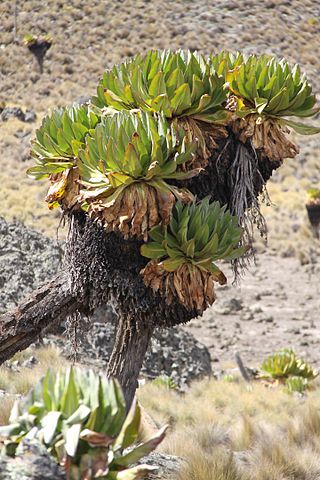
Dendrosenecio keniodendron or giant groundsel is a species of the genus Dendrosenecio of the large family Asteraceae and is one of the several species of giant groundsels endemic to the high altitudes of the Afrotropics, including Dendrosenecio johnstonii (Senecio battiscombei) occurring on Mount Kilimanjaro, Mount Kenya, and the Aberdare Mountains, Dendrosenecio keniensis occurring the lower alpine zone of Mount Kenya and D. keniodendron occurring in higher and drier sites on Mount Kenya. The giant rosette plants, sometimes 6 metres (20 ft) tall, often grow in even-sized stands, with different understory communities under different-aged stands.

Felicia amelloides, the blue daisy bush or blue felicia, is a hairy, soft, usually perennial, evergreen plant, in the family Asteraceae. It can be found along the southern coast of South Africa. It grows as ground cover and produces many very regular branches. It mostly grows to about 50 cm (1.6 ft) high, rarely to 1 m. The leaves are oppositely arranged along the stems, dark green in colour and elliptic in shape. The flower heads sit individually on up to 18 cm (7 in) long, green to dark reddish stalks. They consist of about twelve heavenly blue ray florets that surround many yellow disc florets, together measuring about 3 cm across. It is also cultivated as an ornamental, and was introduced in Europe in the middle of the 18th century.

Dendrosenecio is a genus of flowering plants in the sunflower family. It is a segregate of Senecio, in which it formed the subgenus Dendrosenecio. Its members, the giant groundsels, are native to the higher altitude zones of ten mountain groups in equatorial East Africa, where they form a conspicuous element of the flora.
Senecio transmarinus is a sometimes straggling member of the flowering plants Asteraceae and species of the genus Senecio a perennial herb that grows on the higher elevations of the Rwenzori Mountains in Uganda. It is also found in Rwanda and the Democratic Republic of the Congo. The inflorescences consist of several flowerheads with large yellow ray florets.
Dendrosenecio meruensis is one of the East African giant groundsel, this one is endemic to the slopes of Mount Meru. Once they were considered to be of the genus Senecio but since then have been reclassified into their own genus Dendrosenecio.
Dendrosenecio cheranganiensis is one of the East African giant groundsel, this one endemic to the Cherangani Hills. Once it was a genus of Senecio but has recently been reclassified as a Dendrosenecio.
Dendrosenecio elgonensis is one of the giant groundsel of East Africa; this one is endemic to Mount Elgon. They used to be considered part of the genus Senecio but recently have been reclassified to their own genus, Dendrosenecio.
Dendrosenecio johnstonii, formerly Senecio johnstonii, is a species of giant groundsel found in the middle altitudes of Mount Kilimanjaro in Africa. A recent botanical reclassification split off some species formerly in Senecio, putting the giant groundsels in the new genus Dendrosenecio. It also redefined the former species Senecio cottonii, as a subspecies of Dendrosenecio johnstonii. Both genera are in the family Asteraceae. The giant grounsels of the genus Dendrosenecio evolved, about a million years ago, from a Senecio that established itself on Mount Kilimanjaro, with those that survived adapting into Dendrosenecio kilimanjari. As it moved down the mountain, the adaptations necessary for the new environment created the new species, Dendrosenecio johnstonii. Various subspecies are found on other mountains.
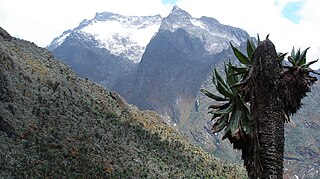
Dendrosenecio adnivalis is one of the giant groundsels of the mountains of Eastern Africa. D. adnivalis grows on the Rwenzori Mountains and on the Virunga Mountains in Uganda and the Democratic Republic of Congo.
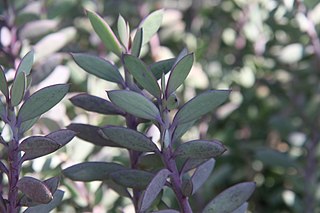
Senecio crassissimus, the propeller plant, vertical leaf or lavender steps, is a succulent species of flowering plant in the daisy family Asteraceae, and is endemic to the island of Madagascar off the east coast of Africa.
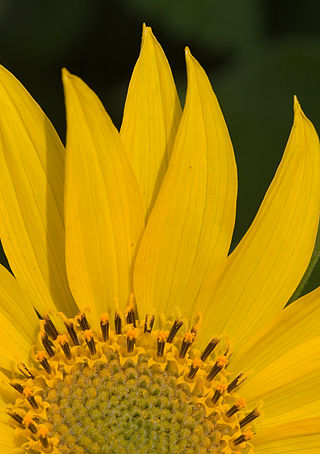
Balsamorhiza deltoidea is a species of flowering plant in the sunflower tribe of the plant family Asteraceae known by the common name deltoid balsamroot. It is native to western North America from British Columbia to California, where it grows in many types of generally mountainous habitat.

Barkleyanthus is a monotypic genus of flowering plants in the aster family, Asteraceae, containing the single species Barkleyanthus salicifolius, a plant formerly classified in the genus Senecio. It is native to North and Central America, where its distribution extends from the southwestern United States to El Salvador. Its common names include willow ragwort, willow groundsel, Barkley's-ragwort, and jarilla.

Warionia is a genus in the tribe Cichorieae within the family Asteraceae. The only known species is Warionia saharae, an endemic of Algeria and Morocco, and it is locally known in the Berber language as afessas, abessas or tazart n-îfiss. It is an aromatic, thistle-like shrub of ½–2 m high, that contains a white latex, and has fleshy, pinnately divided, wavy leaves. It is not thorny or prickly. The aggregate flower heads contain yellow disk florets. It flowers from April till June. Because Warionia is deviant in many respects from any other Asteraceae, different scholars have placed it hesitantly in the Cardueae, Gundelieae, Mutisieae, but now genetic analysis positions it as the sister group to all other Cichorieae.
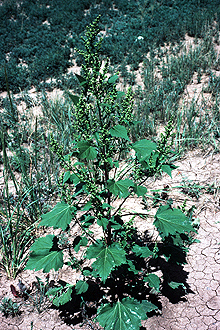
Cyclachaena xanthiifolia, known as giant sumpweed, or rag sumpweed is a North American plant species in the sunflower family, Asteraceae. It is the only species in the genus Cyclachaena. Giant sumpweed is believed to be native to the Great Plains but is now found across much of southern Canada and the contiguous United States, though rarely in the Southeast.

Mairia hirsuta is a tufted perennial, herbaceous plant of up to 40 cm high, that is assigned to the family Asteraceae. Most of its narrow to broad elliptic or inverted egg-shaped leaves are part of the basal rosette, have margin that is rolled under, with rounded or pointy teeth or with some peg-like extensions, lightly woolly on the upper surface and densely woolly on the underside, but always the green remains visible. Flower heads have been found from July to November, mostly after a fire or when the soil has been disturbed. The species can be found in the southern mountains of the Western Cape province of South Africa.
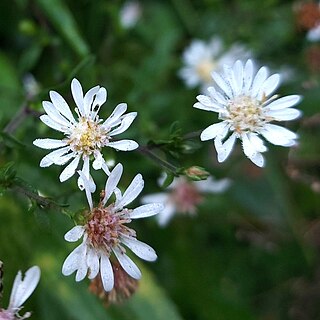
Symphyotrichum schaffneri is a perennial, herbaceous species of flowering plant in the family Asteraceae native to the states of Puebla and Veracruz, Mexico.
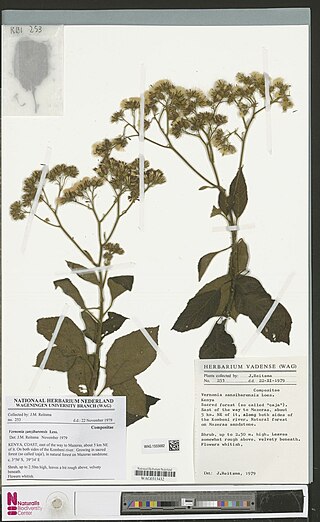
Jeffreycia is a genus of African flowering plants in the family Asteraceae. They are in the tribe Vernonieae.














